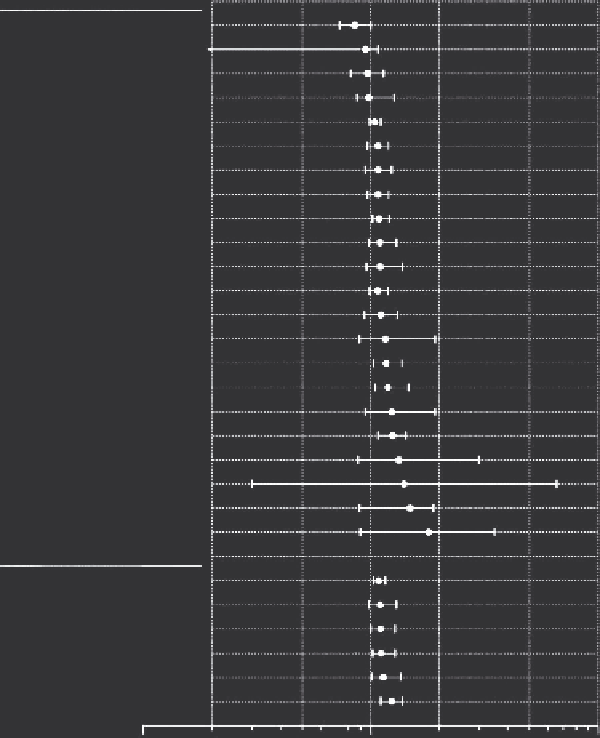Environmental Engineering Reference
In-Depth Information
Individual studies
Alavanja et al. (1999) [A18]
Blot et al. (1990) [B25]
Kreienbrock et al. (2001) [K18]
Letourneau et al. (1994) [L25]
Baysson et al. (2004) [B33]
Darby et al. (1998) [D15]
Alavanja et al. (1998) [A19]
Kreuzer et al. (2003) [K17]
Tomasek et al. (2001) [T10]
Wichmann et al. (2004) [W18]
Lagarde et al. (2001) [L32]
Pershagen et al. (1992) [P16]
Auvinen et al. (1996) [A5]
Pershagan et al. (1994) [P11]
Lagarde et al. (1997) [L1]
Non-smokers
Non-smokers
Wang et al. (2002) [W13]
Field et al. (2000) [F11]
Oberaigner et al. (2002) [O2]
Lagarde et al. (2002) [L31]
Pisa et al. (2001) [P6]
Schoenberg et al. (1990) [S42]
Ruosteenoja et al. (1996) [R3]
Non-smokers
Pooled analyses
European [D17]
German [W19]
Pooled Lubin and Boice (1997)* [L4]
North American [K1]
Lubin Chinese [L36]
Pavia meta analysis [P17]
0.1
0.2
0.5 1
Relative risk (at 100 Bq m
-3
)
2
5
10
FIGURE 21.8
Residential lung cancer risk estimates from 23 case control studies and six pooled or
meta-analyses. *at 150 Bq m
−3
(From UNSCEAR,
Sources-to-Effects Assessment for Radon in Homes and
Workplaces
, United Nations Scientiic Committee on the Effects of Radiation, New York, 2006.)
Even at 10 km into the troposphere, near stratospheric heights, the concentration has been measured
at 0.1 Bq m
−3
.
Along with their parent radon, the alpha-emitting short-lived decay products of
222
Rn are also
present in any atmosphere. The decay products are never in steady state or equilibrium with the par-
ent radon. Indoors, estimated equilibrium ratios are 40% and outdoors 60%. The decay products are
atoms of lead and polonium and upon formation rapidly attach to the local aerosol particles. A fraction
of these aerosol particles deposit on the bronchial airway surfaces and deliver the lung dose of rel-
evance. The majority of lung cancers associated with
222
Rn exposure are located in the upper airways.
Radon in water can add measurably to indoor air concentrations. The release of the gas during
water use adds on average 1 unit to air for 10,000 units in water. Air concentrations derived from
water can in some cases require remediation of the water. The dose to other organs, such as the
stomach, is small compared with the lung dose from the gas release. A few countries have set con-
centration limits for
222
Rn in drinking water.
A fraction of
222
Rn gas is soluble and retained in blood and body tissues. A dose to a fetus from
222
Rn in maternal drinking water must be considered because of this solubility. Estimated dose to

Search WWH ::

Custom Search